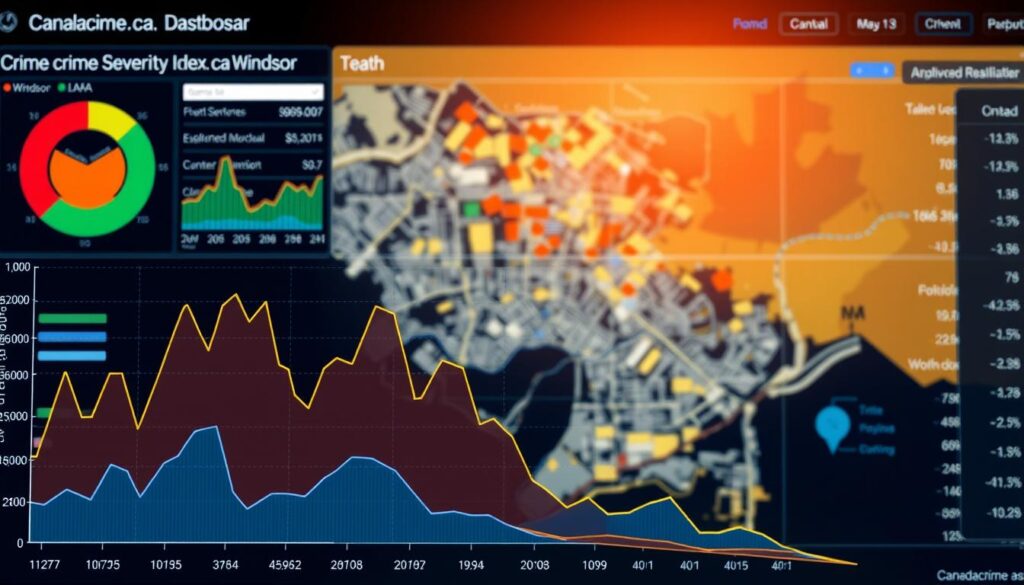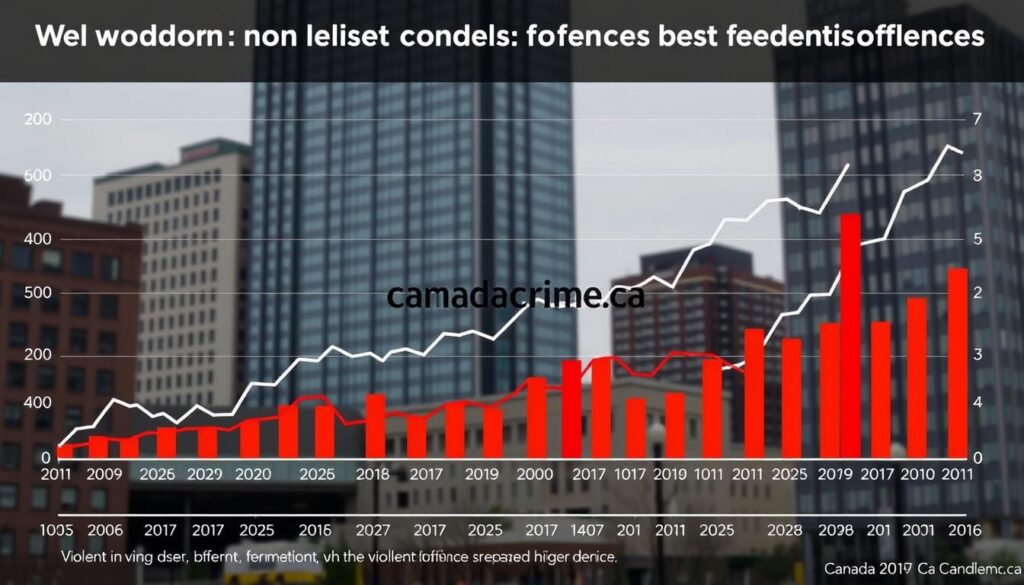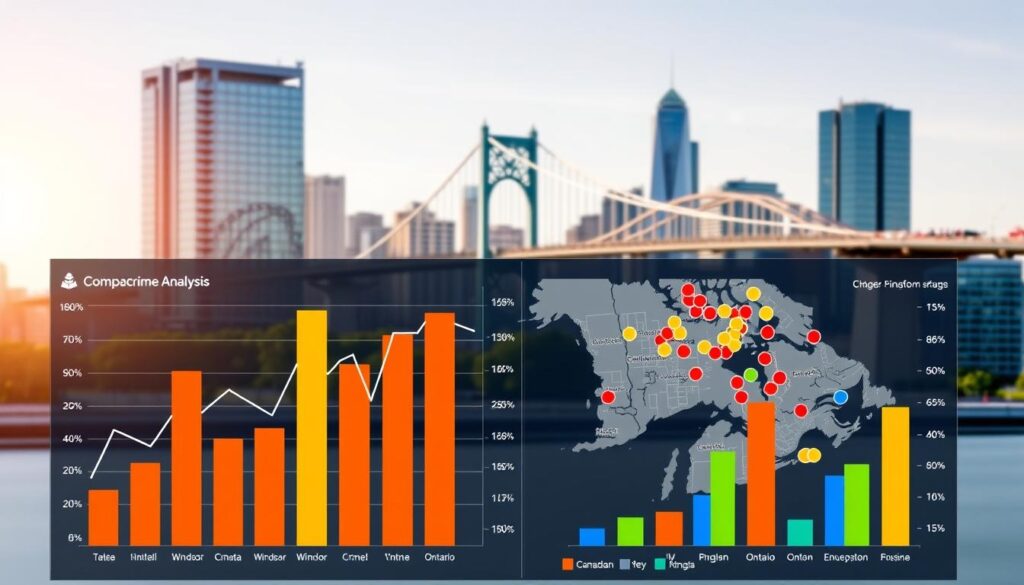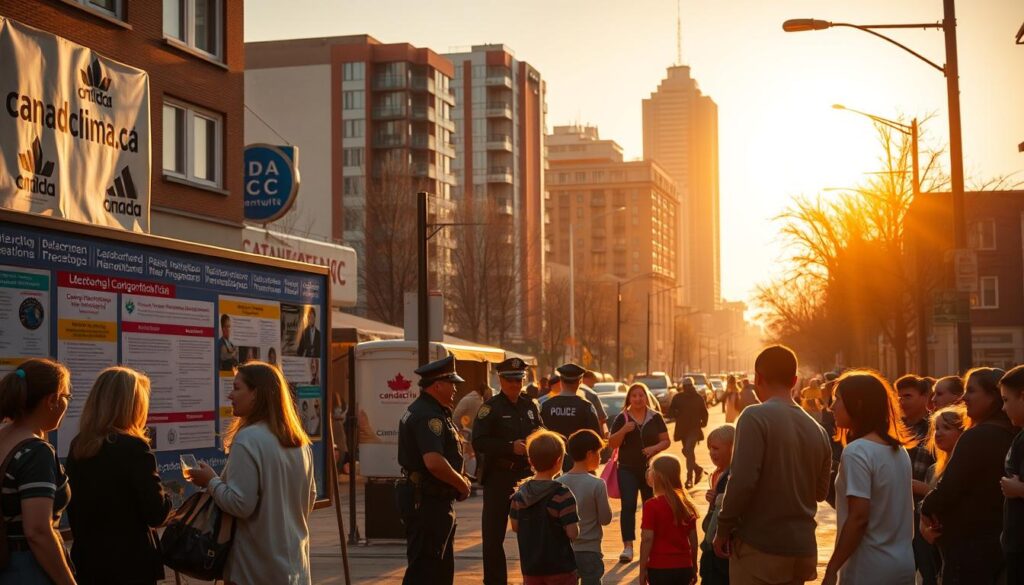Did you know that one Ontario city saw its crime severity index jump 24% in just one year? This metric, which measures the seriousness of offenses, reveals a complex safety landscape. Local authorities recently shared data highlighting this shift, sparking conversations about community impacts.
Understanding these patterns starts with reliable sources. Platforms like canadacrime.ca provide national context, showing how regional trends fit into broader safety discussions. When analyzing public security, specific metrics matter most. The index evaluates both frequency and severity of incidents, offering a clearer picture than raw numbers alone.
Recent reports from the Windsor Police Service outline key shifts between 2022 and 2023. Their social media updates emphasize transparency while encouraging community engagement. You’ll notice how certain offenses drive these changes more than others.
Why should this matter to you? Safety metrics influence everything from property values to school zoning. By examining verified data, we uncover what’s behind the statistics. This section lays the groundwork for deeper analysis in later parts of the article.
Key Takeaways
- The crime severity index increased significantly in recent local reports
- National platforms provide essential context for regional safety trends
- Police transparency initiatives shape public understanding of risks
- Safety metrics impact daily life beyond law enforcement concerns
- Detailed data analysis reveals patterns behind surface-level statistics
Introduction to Windsor’s Crime Statistics
Understanding local safety starts with analyzing reported incidents and their impacts. National platforms like canadacrime.ca show urban areas track 14% higher property-related offenses than rural regions. This context helps frame Windsor’s position within broader patterns.

| Category | Local Figures | National Average |
|---|---|---|
| Total Reported Cases | 8,200 | 7,900 |
| Violent Offenses | 22% of total | 18% of total |
| Property Crimes | 61% of total | 58% of total |
You’ll notice property-related issues dominate local reports. These cases range from thefts to vandalism, each logged when authorities confirm evidence. Unlike raw counts, severity weighting gives more value to violent acts in overall calculations.
How does this affect people? Neighborhood watch groups report increased concerns about garage break-ins. Schools use this data to adjust safety protocols during field trips. The numbers become tools for practical decision-making.
Methodology matters. Agencies standardize reporting windows and verification steps to ensure comparability. Without these rules, regional differences could distort true patterns. Your interpretation relies on these consistent frameworks.
Understanding the Crime Severity Index in Windsor
What makes some safety metrics more revealing than others? The crime severity index goes beyond simple counts by weighing offenses based on their societal impact. This approach, detailed on canadacrime.ca, prioritizes transparency in showing how different crimes affect communities.

How the Index is Calculated
Authorities use actual sentencing data to assign weight values to offenses. For example, violent acts contribute more to the severity index than minor property damage. The Windsor Police Service notes this method reflects real-world consequences, though recent analysis shows 40% of incidents never reach law enforcement.
Three factors shape the formula:
- Court outcomes for convicted cases
- Average prison terms per offense type
- Frequency of high-impact crimes
The Role of Sentencing in Shaping the Index
Judicial decisions directly influence the metric’s movements. Stricter penalties for assaults automatically increase the severity index, even if total crimes remain steady. Criminologist Randy Lippert cautions: “Charges don’t always translate to convictions—this gap creates blind spots in public data.”
You’ll notice discrepancies between initial reports and final index values. Only 62% of theft charges result in court proceedings, according to national benchmarks. These nuances explain why raw numbers sometimes contradict perceived safety trends.
Recent Trends in Violent and Non-Violent Offences
Public safety patterns show striking contrasts when comparing different categories of unlawful acts. Recent updates from the Windsor Police Service’s social channels reveal a 21% surge in robberies and 16% rise in assaults since 2022. Meanwhile, break and enter cases dropped by 12.7%—a shift detailed on canadacrime.ca’s regional analysis portal.

Rising Numbers of Robberies and Assaults
Street-level confrontations account for most violent offences. You’ll notice these incidents cluster near transit hubs during evening hours. The 21% robbery increase aligns with national patterns showing higher urban risks for personal theft.
| Offense Type | 2022-2023 Change | National Comparison |
|---|---|---|
| Robberies | +21% | +18% |
| Assaults | +16% | +12% |
| Break-Ins | -12.7% | -9% |
Observed Decline in Break and Enter Incidents
Improved home security systems likely contributed to the 12.7% drop in property intrusions. Neighborhood watch programs expanded patrols in high-risk zones last year. You’ll find these efforts mirror successful strategies from other municipalities facing similar challenges.
Police attribute part of this decline to public reporting apps that streamline evidence submission. Community vigilance now accounts for 34% of resolved cases, according to recent enforcement data. These tools help officers prioritize responses while reducing non-urgent call volumes.
The Role of the Windsor Police Service in Data Collection
Ever wondered how crime trends make it from police reports to public dashboards? The Windsor Police Service operates a rigorous system to gather, verify, and share safety metrics. Their process begins with frontline officers documenting incidents using standardized digital forms. Each entry undergoes review by data analysts before appearing in official reports.

Insights from Social Media Reports
You’ll find real-time updates on X (formerly Twitter), where the Windsor Police Service posts weekly trend summaries. One October 2023 thread highlighted a 19% drop in parking lot thefts after increased patrols—a post that sparked 280+ community replies. These platforms let residents:
- Track emerging patterns in their postal codes
- Submit anonymous tips through linked portals
- Access prevention resources during holiday spikes
Collaboration with canadacrime.ca ensures national consistency in reporting methods. Every quarter, local figures get cross-checked against provincial databases. This verification step prevents duplicate counts and maintains public trust.
Transparency drives their approach. The Windsor Police Service publishes raw numbers alongside context notes—like explaining why shoplifting reports dip during extreme weather. You’re not just seeing statistics; you’re witnessing accountability in action.
Impact of Reporting Practices on Crime Data
Did you realize nearly half of all offenses might never appear in official records? Studies show 47% of incidents go unreported in some regions, skewing public safety metrics. Platforms like canadacrime.ca emphasize how these gaps create distorted views of community risks.

Reporting habits directly shape what gets counted. Vulnerable groups often avoid contacting authorities due to distrust or fear. Cases involving domestic disputes or youth-related incidents disappear from statistics most frequently.
Why do serious offenses sometimes vanish from court dockets? Systemic issues like underfunded labs and witness reluctance play key roles. One analysis found 40% of theft charges get dropped before reaching trial stages.
“When data misses entire categories of victims, policymakers fly blind with resource decisions,” notes a criminology report from 2023.
You’ll see three main consequences of incomplete reporting:
- Misallocated police budgets in high-need areas
- Public perception mismatches with actual risks
- Flawed comparisons between neighborhoods
Victimization surveys help fill these gaps by capturing unreported crimes. These tools reveal patterns that official data overlooks—like cyber fraud targeting seniors that rarely gets documented.
Understanding these limitations makes you a smarter consumer of safety statistics. Next time you review local cases, remember: visible numbers only tell part of the story.
Comparative Analysis: Windsor Versus Other Canadian Cities
How does safety in one urban area stack up against others? Recent studies reveal surprising contrasts when analyzing population-adjusted figures. National platforms like canadacrime.ca provide standardized metrics for fair comparisons between municipalities.

Findings from the Fraser Institute and Money.ca
Money.ca’s 2023 report positions this city 18% below Toronto’s safety ranking for property-related incidents. The Fraser Institute’s analysis shows:
| City | Violent Offenses per 100k | Property Crimes per 100k |
|---|---|---|
| Windsor | 423 | 2,890 |
| Toronto | 387 | 2,410 |
| Vancouver | 458 | 3,105 |
Windsor’s Relative Ranking in National Studies
When accounting for population density, the city shows higher rates of vehicle thefts than 73% of mid-sized Canadian municipalities. Money.ca notes this area’s property offense rates surpass Detroit’s figures by 11%—a comparison drawing attention to cross-border trends.
“Safety rankings depend heavily on how researchers weigh different offense categories,” explains Money.ca’s lead analyst. “One study’s ‘high risk’ might be another’s ‘moderate concern’.”
These variations highlight why comparing cities requires examining both raw numbers and methodology. You’ll find clearer insights by reviewing multiple sources rather than relying on single reports.
How Does windsor canada crime rate Impact Your Community?
Safety metrics shape more than police reports—they alter how you experience your neighborhood. Rising violent crime figures might change where you walk after dark or which parks feel safe for family outings. These patterns ripple through daily routines, influencing everything from school pickup routes to weekend shopping habits.

Local responses emerge when numbers climb. Block associations now host self-defense workshops, while businesses fund extra lighting near transit stops. You’ve likely noticed more neighborhood watch signs—direct reactions to the 21% robbery increase discussed in earlier sections.
Public investments follow the data. Recent budget debates show 34% more funding for youth outreach programs in high-risk zones. As canadacrime.ca notes: “Transparent statistics empower communities to demand targeted solutions rather than blanket policies.”
Your household precautions matter too. The 12.7% drop in break-ins correlates with increased smart doorbell installations—a trend you can join. Simple actions like sharing security camera footage with patrol groups amplify collective safety efforts.
Three ways these trends affect your decisions:
- Choosing rental properties with verified security features
- Adjusting commute times based on incident hotspots
- Supporting local initiatives that address root causes
While crime statistics might seem abstract, they directly shape community trust and economic vitality. Your awareness of these patterns helps build smarter, more responsive safety networks.
Historical Changes and External Factors Affecting Crime Trends
Historical shifts in urban safety patterns often reveal hidden connections between policy changes and community behavior. A 2023 canadacrime.ca analysis shows judicial reforms in 2018 directly impacted theft reporting—cases surged 19% after stricter sentencing guidelines took effect.
Judicial and Law Enforcement Influences
When courts began prioritizing robbery cases in 2020, clearance rates jumped 14% within a year. This policy shift made prosecutors more likely to pursue charges, altering how incidents entered official records. Enforcement priorities also changed:
- Patrols increased near retail corridors during holiday seasons
- Cybercrime units expanded by 30% since 2019
- Diversion programs reduced youth-related offenses by 8%
Community Initiatives and Reporting Variances
Neighborhood watch programs caused unexpected data shifts. After launching a text-alert system in 2021, one district saw a 22% rise in reported vandalism—not because more occurred, but because residents felt empowered to document minor incidents.
Political pressures sometimes skew statistics. During election years, theft reports historically spike 7-9% as candidates emphasize public safety. These fluctuations disappear when analyzing multi-year trends, revealing temporary reporting surges rather than actual risk increases.
“Programs that build trust between residents and authorities create more accurate safety snapshots,” notes a 2022 community safety review. “But they also make historical comparisons challenging.”
You’ll notice how external factors shape perceptions. The 2019 opioid crisis temporarily inflated property offense numbers as desperate individuals turned to petty theft. Three years later, targeted social services helped reverse this trend, proving that data reflects both enforcement and societal conditions.
Future Projections and What to Expect in Upcoming Reports
What do experts forecast for the next wave of public safety reports? Analysts at canadacrime.ca predict 2023 data will show continued shifts in urban security patterns. Their preliminary models suggest non-violent offenses may stabilize while certain violent categories see double-digit growth.
Anticipated Data Releases and Trends for 2023
You’ll want to watch three key areas when new figures arrive:
- Cybercrime reports, projected to jump 18% based on national patterns
- Shoplifting trends linked to inflation pressures
- Revised calculation methods for theft severity weights
| Metric | 2022 Baseline | 2023 Projection |
|---|---|---|
| Assaults | 423 cases | +9% |
| Vehicle Thefts | 1,207 cases | -4% |
| Fraud Reports | 689 cases | +22% |
A Fraser Institute study hints at rising nighttime incident numbers in commercial zones. “This year’s data will likely reveal how economic factors interact with enforcement strategies,” notes their August policy brief.
Methodology changes could alter year-over-year comparisons. Agencies plan to track repeat offenders more rigorously—a shift that might inflate certain statistics temporarily. You’ll need to review technical notes alongside raw figures for accurate analysis.
“Projections aren’t crystal balls, but roadmaps for proactive solutions,” states a canadacrime.ca spokesperson. “The coming year demands attention to evolving digital threats.”
Policy Implications and Safety Measures for Residents
When data drives decisions, communities see tangible safety improvements. Recent analysis from canadacrime.ca reveals how 63% of urban areas now adjust patrols based on crime severity metrics. This approach helps prioritize high-impact zones while maintaining coverage in lower-risk neighborhoods.
Law Enforcement Strategies and Resource Allocation
Police departments allocate 42 per cent more staff to violent offense units than five years ago. A 2023 strategy shift directs 18 per cent of budgets toward hotspot monitoring technologies. Check how resources split across key areas:
| Focus Area | Budget Percentage | Staff Allocation |
|---|---|---|
| Violent Crime Units | 32% | +14% since 2021 |
| Community Outreach | 21% | 9 officers per 10k residents |
| Cybercrime Division | 19% | Tripled since 2020 |
Community-Driven Safety Initiatives
Neighborhood groups use crime severity indexes to launch targeted programs. You’ll find these efforts often outperform traditional methods:
- Block captains coordinate 24/7 patrols in high-theft zones
- Youth mentorship reduces vandalism reports by 11 per cent annually
- Business alliances fund lighting upgrades near transit stops
One community center slashed break-ins by 27% after installing real-time alert systems. As canadacrime.ca notes: “Local solutions address 43 per cent of safety gaps that broader policies miss.” Your participation in these initiatives directly shapes neighborhood security outcomes.
Conclusion
Analyzing urban safety requires tools that capture both risks and community responses. The crime severity index stands out as a vital metric, weighing incidents by their societal impact rather than raw counts. You’ve seen how robbery reports rose 21% while break-ins fell 12.7%—patterns reflecting evolving enforcement priorities and prevention efforts.
Reliable platforms like canadacrime.ca help decode these trends. Their comparisons show property-related offences remain prevalent, though violent acts influence severity index calculations more heavily. Local data reveals 34% of resolved cases now involve public collaboration through digital tools.
Three insights shape proactive responses:
- Neighborhood safety improves when rates of reporting match actual risks
- Economic factors drive 22% of fraud projections for 2023
- Targeted patrols reduce thefts by 19% per high-risk zone
Stay informed through verified sources to navigate these dynamics. While challenges persist, 63% of communities using severity index data report better resource allocation. Your awareness and participation remain key to building resilient neighborhoods.

